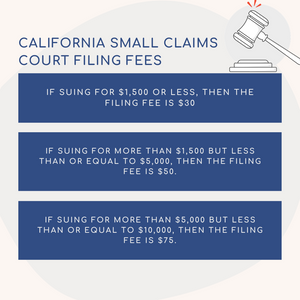Contents
You scored a great pair of limited edition shoes online and patiently waited for them to get delivered but it has been a few weeks from when they were supposed to arrive. Essentially, you bought an item but you never received it, How can you get the money back? You have several options including suing in small claims court in California.
In this article, learn about:
First, let's check the options before going to the Small Claims Court
How to write a demand letter.
How to File a Small Claims Lawsuit in California
Small claims court limits.
Fun fact, lawyers are not allowed at the initial small claims hearing! This is to even the playing field so that each party has an equal chance of obtaining justice.
Reach out to the Seller 
The first thing to do when a problem arises is to communicate with the seller that you have not received the item you purchased. Most of the time, they will agree to give you a full or partial refund. If this doesn't work, then it is time to escalate the problem.
Save All Evidence
You want to make sure to save all evidence related to the purchase.
Examples of Evidence
Invoice, receipt, or document indicating you purchased the item.
Venmo, Paypal, or Bank Statements showing you paid for the item and how much the item was.
Any information you have about the seller including their address, phone number, and website.
Evidence that demonstrates when the item was supposed to be delivered.
If you purchased the item on Facebook Marketplace, make sure to save the Facebook Messenger conversation with the seller.
Any additional communication you have including emails, text messages, or chat conversations you have received from the seller.
Evidence of partial refunds if the seller has partially refunded you.
Send a Demand Letter
A demand letter is a letter that outlines a set of requests. For example, you could request a refund for the item you purchased and explain why you are requesting a refund.
If you eventually decide to sue in California small claims court, you are required to first request your money or property back before you can file the lawsuit. While you can request your money or property back orally, it is recommended you do so in writing in the form of a demand letter.
What to include in the demand letter?
Unsure of what to include in your demand letter addressed to the seller? Here are a few suggestions:
How much money you are owed.
Why you are owed money.
Your contact information.
Where to send payment.
Give them a few days to respond (usually about 7 to 14 days).
State that if they don't respond, you intend to sue.
Small Claims Court
If the seller ignored your demand letter, what next? You can sue the seller in small claims court. But first, some background on small claims court in California to determine if it is right for you.
Types of Cases that Can be Filed in Small Claims
So long as there isn't another court better suited to hear the case, then the lawsuit can be filed in small claims. Suing for an item you purchased but didn't receive is a common small claims court lawsuit.
How much can I sue for in a Small Claims Court California?
This is also known as the "small claims court limits." In California Small Claims you can sue for the following maximum amounts:
Starting the Small Claims Court Lawsuit Against the Seller
Step 1: Fill out "Plaintiff's Claim and Order to Go to Small Claims Court" (Form SC-100)
This form starts the California Small Claims Court lawsuit process.
It is also known as the "complaint" or "claim."
This is the first document you need to file if you are suing someone. Download here.
The form will ask you who the agent for service of process is. If the seller is incorporated as a Corporation or LLC, you can search for the Agent for Service of Process on the California Secretary of State's Website.
Step 2: File "Plaintiff's Claim and Order to Go to Small Claims Court"
Each California Small Claims Court has a different procedure for filing. You have to check with your local small claims court whether they allow filing in-person, by mail, online, or by fax. Or we can file your case for you!
Step 3: Serve the Seller
Once you file your California small claims court lawsuit, the next step is to notify the seller that they have been sued. This is called "service of process" (also known as "service"). You must serve the seller at least 15-20 days before the small claims court hearing. There are several ways you can serve the seller including by having a friend serve, hiring a process server, hiring the sheriff, or through the court clerk. We can help you with serving the small claims lawsuit.
The Small Claims Court Hearing
Once you file your case, you will get a hearing date scheduled anywhere between 30-70 days later. During this time, the seller may call you to try and settle the case.
To prepare for your small claims court hearing:
Prepare your evidence. For example, your communications, any emails, receipts, etc. You want to have your evidence organized with titles, dates, and why that piece of evidence is important. All your evidence should be geared towards showing the judge why you are correct.
Prepare what to say. During the hearing, the judge will ask you why you are suing. The judge will then turn to the seller or their representative and ask why they should win the case. Small Claims Court hearings usually last around 15 minutes.
Get your receipts for costs ready. For example, any filing fees and any process server costs. Make sure to let the judge know that you would like to be reimbursed for costs. Generally, whoever wins the case can be reimbursed for "reasonable costs."
Print enough copies of all your evidence. You will need at least three copies (one for you, one for the judge, one for the other side).
How much can I sue for in a Small Claims Court California?
This is also known as the "small claims court limits." In California Small Claims you can sue for the following maximum amounts:
Starting the Small Claims Court Lawsuit Against the Seller
Step 1: Fill out "Plaintiff's Claim and Order to Go to Small Claims Court" (Form SC-100)
This form starts the California Small Claims Court lawsuit process.
It is also known as the "complaint" or "claim."
This is the first document you need to file if you are suing someone. Download here.
The form will ask you who the agent for service of process is. If the seller is incorporated as a Corporation or LLC, you can search for the Agent for Service of Process on the California Secretary of State's Website.
Step 2: File "Plaintiff's Claim and Order to Go to Small Claims Court"
Each California Small Claims Court has a different procedure for filing. You have to check with your local small claims court whether they allow filing in-person, by mail, online, or by fax. Or we can file your case for you!
Step 3: Serve the Seller
Once you file your California small claims court lawsuit, the next step is to notify the seller that they have been sued. This is called "service of process" (also known as "service"). You must serve the seller at least 15-20 days before the small claims court hearing. There are several ways you can serve the seller including by having a friend serve, hiring a process server, hiring the sheriff, or through the court clerk. We can help you with serving the small claims lawsuit.
The Small Claims Court Hearing
Once you file your case, you will get a hearing date scheduled anywhere between 30-70 days later. During this time, the seller may call you to try and settle the case.
To prepare for your small claims court hearing:
Prepare your evidence. For example, your communications, any emails, receipts, etc. You want to have your evidence organized with titles, dates, and why that piece of evidence is important. All your evidence should be geared towards showing the judge why you are correct.
Prepare what to say. During the hearing, the judge will ask you why you are suing. The judge will then turn to the seller or their representative and ask why they should win the case. Small Claims Court hearings usually last around 15 minutes.
Get your receipts for costs ready. For example, any filing fees and any process server costs. Make sure to let the judge know that you would like to be reimbursed for costs. Generally, whoever wins the case can be reimbursed for "reasonable costs."
Print enough copies of all your evidence. You will need at least three copies (one for you, one for the judge, one for the other side).
What are the California Small Claims Court Filing Fees?
The amount you will pay to file a small claims lawsuit in California depends on how much you are suing for. You will pay between $30 to $75 to file the lawsuit. If cannot afford to pay court fees, you can ask the court to waive the fees.

What are other costs for Small Claims Court?
In most small claims cases, you can expect to pay:
Filing fees (see above) $30- $75
Serving Costs can range from $0-$75 per person you sue.
If you win, you can request that the losing party pay for your court fees and serving costs.
To know more about how to File a California Small Claims court lawsuit Check out our How to File your California Small Claims Court Case article.
The Hearing
If both parties show up:
Right before the hearing, the judge will ask you and the person you sued to show each other the evidence that they have brought with them.
The Judge will ask you why you are suing.
Then the person who is being sued will get to present their side of the story.
The hearing will last around 15 minutes.
The judge will ask you to show the judge the evidence you brought with you. Sometimes the judge will keep the evidence. Otherwise, you will get the evidence right back.
Very rarely a judge will tell you who won or lost immediately after the hearing. Instead, the judge will tell you that their decision will be mailed to them (usually takes a few weeks to two months or so).
If only you show up but the person you sued does not show up:
You still have to prove to the judge why you should win.
If only the defendant shows up:
The judge will close the lawsuit.
Why sue in California Small Claims court?
California Small Claims Court provides a public forum for quick, efficient, and affordable resolution of disputes. In California, your landlord will not be allowed to have an attorney at the small claims hearing. This is done so that there is an even playing field.

Camila Lopez, Esq.
Attorney at JusticeDirect. Camila holds a law degree and is a certified mediator. Her passion is breaking down complicated legal processes so that people without an attorney can get justice.

